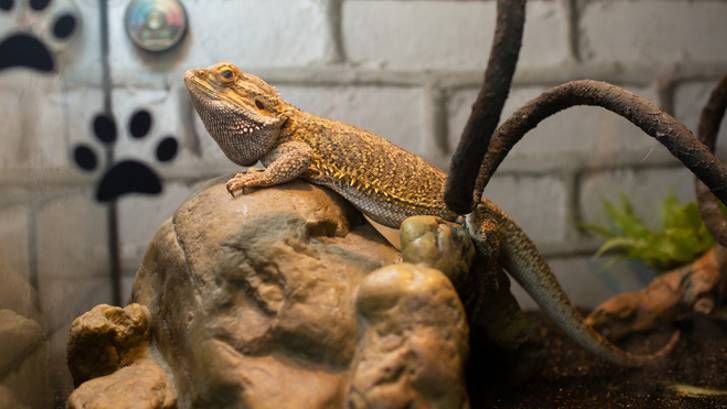Creating the ideal environment for your bearded dragon is crucial to keeping them healthy and happy. One of the most important factors in their habitat is maintaining proper bearded dragon tank temperature. Unlike humans, reptiles like bearded dragons cannot regulate their own body temperature and rely on external heat sources. Having the right temperature range in their enclosure allows them to properly digest food, have enough energy to be active, and strengthen their immune system. Getting the temperatures wrong can lead to major health issues and in some cases, even be fatal. In this article, we will explore ideal bearded dragon tank temperature ranges, ways to measure and control the temperature, and signs that the tank may be too hot or cold for your pet.
The Importance of Proper Bearded Dragon Tank Temperatures

Bearded dragons are native to the deserts of Australia. Because of this, they thrive in warm, dry environments. Their optimal enclosure temperature range is between 75-110°F. Different areas of the tank should have varying temperatures so the bearded dragon can self-regulate by moving between the cooler and warmer zones as needed. There should be a basking spot that reaches 100-110°F, a warm side around 90°F, and a cooler side down to 75°F. At night, the temperature can drop to around 70°F. Staying within these bearded dragon tank temperature ranges is critical for your pet’s health.
Temperatures that are too low can prevent your bearded dragon from properly digesting their food, lead to appetite loss, and cause inactivity or lethargy. Low temperatures mean the bearded dragon has to use more energy trying to stay warm rather than for nourishment and growth. Prolonged exposure to cold can weaken their immune system and make them prone to respiratory infections. Temperatures that are too high can also be detrimental. Bearded dragons have a hard time sweating or panting to cool down like dogs or humans. If a tank is too hot, they are at risk of overheating and heat stroke, which can be fatal. Ideal bearded dragon tank temperature ranges keep your pet active while preventing the harms of under-heating or over-heating.
Measuring and Regulating Temperatures in the Tank
Since maintaining proper heating is so important, you need to both measure and control the bearded dragon tank temperature. Digital thermometers are the most accurate way to monitor the enclosure’s temperatures. Place thermometers on both the cool side and the warm side to get full readings. The probe of a temperature gun can also provide precise readings when pointed at different spots in the habitat.
There are several types of fixtures that can provide heat, including incandescent bulbs, ceramic heat emitters, under tank heating pads, and more. Switching fixtures on and off and arranging their placement allows adjustment of both the basking spot and ambient temperatures. For example, an incandescent bulb focused on one side over the basking area paired with an under tank heater on the other side can create temperature gradients. Thermostats control the output of heating devices to prevent uncontrolled fluctuations in bearded dragon tank temperature.
Signs of Improper Temperatures in Bearded Dragon Tanks

It’s important to watch your bearded dragon’s behavior in their habitat to spot signs that the tank temperature may be off. If they are avoiding the warm side and huddling on the cool side, it likely means the ambient temperature is too hot. Excessive gaping with an open mouth can also signal overheating. On the other hand, lethargy, not basking under warm lighting, decreased appetite, and slow digestion point to a tank that is too cold overall.
Take note if your bearded dragon is showing signs of frequent stress, illness” or has trouble shedding. These can occur when temperatures are not optimal. Keeping the temperature in the proper ranges will lead to more natural behaviors like basking, regular appetite and digestion, and active movements around the tank. Adjust heating elements and measure again if you see abnormalities until their behavior improves.
Conclusion
A bearded dragon’s tank temperature needs to be treated with care and attention. Improper heating is detrimental to their health and can even be fatal in some cases. Monitor the temperature with thermometers and make adjustments as needed to maintain a basking spot of 100-110° F, a warm side around 90°F, and a cooler side down to 75°F. Observe how your bearded dragon is acting and reacting to identify signs the tank may be too hot or cold. With the right temperature ranges and setup, your bearded dragon will thrive.
FAQs About Bearded Dragon Tank Temperature
Are there variations in temperature requirements based on a bearded dragon’s age or species?
Temperature requirements remain relatively consistent across ages and species, with minor variations. Young dragons may prefer slightly higher basking temperatures.
Can I use heat mats or heat rocks as a heat source for my bearded dragon?
It’s not recommended to use heat mats or rocks as the primary heat source, as they can cause burns. Stick to basking lamps or ceramic heat emitters for safety.
How does the temperature affect a bearded dragon’s metabolism, behavior, and overall health?
Temperature impacts their metabolism, digestion, and activity level. Proper temperature regulation ensures they can eat, digest, and behave normally, promoting good health.
What role does humidity play in maintaining the right temperature for a bearded dragon?
Humidity can affect the perceived temperature. Ensure humidity levels are appropriate, as excessive humidity can make it feel warmer, while low humidity can make it feel cooler.
Are there any tips for ensuring consistent and safe temperature levels in a bearded dragon tank?
Use quality thermometers and thermostats, regularly check and maintain heating equipment, and provide a range of temperature zones to ensure your dragon can self-regulate its comfort.



